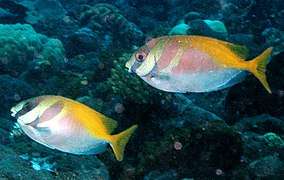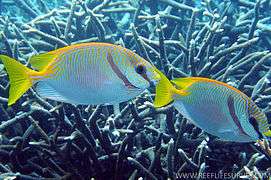Siganus virgatus
Siganus virgatus is a species of marine fish of the family Siganidae, order Perciformes, suborder Acanthuroidei.
| Siganus virgatus | |
|---|---|
 | |
| Scientific classification | |
| Kingdom: | Animalia |
| Phylum: | Chordata |
| Class: | Actinopterygii |
| Order: | Perciformes |
| Family: | Siganidae |
| Genus: | Siganus |
| Species: | S. virgatus |
| Binomial name | |
| Siganus virgatus (Valenciennes, 1835) | |
| Synonyms | |
| |
Its most common name is barhead spinefoot.[2] The term spinefoot is also used, apart from rabbitfish, to designate other species of the genus Siganus.
Morphology
The body of the fish is medium-high, very compressed laterally. Seen from profile it resemblances an ellipse. The mouth is terminal, very small, with non-protrusive jaws.
The base color of the head, the upper half of the body and the fins are pale blue, except for the dorsal and caudal fins, which are yellow. The lower half of the body and the belly are whitish-silvered. The head has a diagonal brown strip that crosses the eye, from the nape of the neck to the chin. Another diagonal brown stripe extends from the base of the 4th or 5th spine to the base of the pectoral fins. Both the head and upper half of the body are decorated with fine spots and yellow and irregular stripes. The central part of the body is a pinkish hue, and the later part of the back is yellow. It is distinguished from its relative S. doliatus, in which the whole body is covered with vertical stripes, more or less parallel, and does not have the base of the yellow dorsal radius.
 S. virgatus has dots and stripes in the upper half of the body, and the base of the yellow dorsal radiuis
S. virgatus has dots and stripes in the upper half of the body, and the base of the yellow dorsal radiuis S. doliatus has stripes all over the body and no rear yellow spot
S. doliatus has stripes all over the body and no rear yellow spot
They have 13 spines and 10 dorsal soft rays, preceded by a short protruding spine, sometimes slightly protruding, and others totally hidden. The anal fin has 7 strong spines and 9 soft spokes. The pelvic fins have 2 spines, with 3 soft spokes between them, unique and distinctive feature of this family. The spines of the fins have two lateral gaps containing venomous glands.[3]
The maximum size of length is 30 cm,[4] although the average adult size is 20 cm.[5]
Reproduction
They are oviparous and they fertilize externally. Eggs are sticky. Spawning occurs at dusk, in the hot months, coinciding with the lunar cycle, in the first quarter of the moon.[6]
They possess a planktonic larval state, and develop a post-larval state, characteristic of the suborder Acanthuroidei, called acronurus, in which the individuals are transparent, and they remain in pelagic state during an extended period before establishing in the definitive habitat, and adopt then the shape and color of adults.
Siganus virgatus is closely related to S. doliatus, with which it is apparently hybridized in the Indo-Malay region.[7]
Feeding
They are mainly herbivores, in 84% of their nourishment.[8] They progress from feeding on phytoplankton and zooplankton, like larvae, to feeding on benthic macroalgae and small invertebrates.[9][10]
Habitat and behaviour
They inhabit in tropical waters, associated with coastal coral reefs, in lagoons and outer reefs. They frequent rocky and hard coral areas with patches of sand. They are tolerant of turbid waters. Large juveniles and adults occur in pairs on slopes of reefs and estuaries. Small juveniles inhabit mangroves, moving to reefs in small groups, protected by coral reefs.[11]
They are diurnal. At night they sleep in cracks, developing a specific coloration of camouflage, in brown tones, and turning off their lively colors, in an exercise of crypsis, that also develop when they are stressed.
Its depth range is between 1 and 20 meters,[12] although some locations are reported up to 39 meters.[13]
Geographic distribution
These fish are found in the western Pacific Ocean and the eastern Indian Ocean.[14] From southern India to Australia, and the Ryukyu Islands to the north.
They are present in Andaman, Australia, Cambodia, China, the Philippines, India, Indonesia, Japan, Malaysia, Papua New Guinea, Ryukyu Islands, Singapore, Sri Lanka, Thailand, Taiwan and Vietnam.[15]
References
- Bailly, N. (2015). Siganus virgatus (Valenciennes, 1835). In: Froese, R. and D. Pauly. Editors. (2015) FishBase. Accessed through: World Register of Marine Species at http://www.marinespecies.org/aphia.php?p=taxdetails&id=273928 Registro Mundial de Especies Marinas. Consultado el 29 de mayo de 2015.
- http://www.fishbase.org/comnames/CommonNamesList.php?ID=4624&GenusName=Siganus&SpeciesName=virgatus&StockCode=4811 FishBase: Nombres comunes de S. virgatus. Consultado el 29 de mayo de 2015.
- Woodland, D.J., (1990) Revision of the fish family Siganidae with descriptions of two new species and comments on distribution and biology. Indo-Pac. Fish. (19):136 p
- Kuiter, R.H. and T. Tonozuka, (2001) Pictorial guide to Indonesian reef fishes. Part 3. Jawfishes - Sunfishes, Opistognathidae - Molidae. Zoonetics, Australia. p. 623-893.
- Woodland, D., (1997) Siganidae. Spinefoots, rabbitfishes. p. 3627-3650. In K.E. Carpenter and V. Niem (eds.) FAO Identification Guide for Fishery Purposes. The Western Central Pacific. 837 p. Available online: http://www.fao.org/docrep/009/x2400e/x2400e00.htm
- http://www.fishesofaustralia.net.au/home/species/1049#moreinfo Fishes of Australia.
- Randall, J.E., G.R. Allen and R.C. Steene, (1990) Fishes of the Great Barrier Reef and Coral Sea. University of Hawaii Press, Honolulu, Hawaii. 506 p.
- http://www.fishbase.org/TrophicEco/DietCompoList.php?ID=4624&GenusName=Siganus&SpeciesName=virgatus&fc=413&StockCode=4811 (in Spanish) FishBase: Dieta de S. virgatus. Consultado el 29 de mayo de 2015.
- Woodland, D.J., (1990) Revision of the fish family Siganidae with descriptions of two new species and comments on distribution and biology. Indo-Pac. Fish. (19):136 p
- http://www.fishbase.org/TrophicEco/FoodItemsList.php?vstockcode=4811&genus=Siganus&species=virgatus (in Spanish) FishBase: Lista de alimentos de S. virgatus. Consultado el 29 de mayo de 2015.
- Kuiter, R.H. and T. Tonozuka, (2001) Pictorial guide to Indonesian reef fishes. Part 3. Jawfishes - Sunfishes, Opistognathidae - Molidae. Zoonetics, Australia. p. 623-893.
- Baensch, H.A. and H. Debelius, (in Spanish) (1997) Atlas Marino. Mergus Verlag GmbH, Postfach 86, 49302, Melle, Alemania. 1216 p. 3ª edición.
- http://www.iobis.org/mapper/?taxon_id=510103 (in Spanish) IOBIS: Sistema de Información Biogeográfica Oceánica. Consultado el 31 de mayo de 2015.
- "Archived copy". Archived from the original on 2015-05-31. Retrieved 2015-06-01.CS1 maint: archived copy as title (link) (in Spanish) FishWisePro: web profesional de peces.
- http://www.fishbase.org/Country/CountryList.php?ID=4624&GenusName=Siganus&SpeciesName=virgatus (in Spanish) FishBase: Lista de países de S. virgatus. Consultado el 31 de mayo de 2015.
Bibliography
•Allen, G.R. & Erdmann, M.V. (2012) (en inglés) Reef fishes of the East Indies. Perth : Tropical Reef Research 3 vols, 1260 pp. Fox, R.J., T.L. Sunderland, A.S. Hoey & D.R. Bellwood (2009) Estimating ecosystem function: contrasting roles of closely related herbivorous rabbitfishes (Siganidae) on coral reefs. Marine Ecology Progress Series 385: 261-260.
•Kuiter, R.H. & Debelius, H. (2001) Surgeonfishes, Rabbitfishes and Their Relatives. A comprehensive guide to Acanthuroidei. Chorleywood, U.K. : TMC Publishing 208 pp.
•Randall, J.E., Allen, G.R. & Steene, R. (1997) Fishes of the Great Barrier Reef and Coral Sea. Bathurst : Crawford House Press 557 pp. figs.
•Woodland, D.J. (2001) Siganidae. pp. 3627-3650 in Carpenter, K.E. & Niem, T.H. (eds). The Living Marine Resources of the Western Central Pacific. FAO Species Identification Guide for Fisheries Purposes. Roma : FAO Vol. 6 pp. 3381-4218.
External links
- Photos of Siganus virgatus on Sealife Collection
| Wikimedia Commons has media related to Siganus virgatus. |
| Wikispecies has information related to Siganus virgatus |